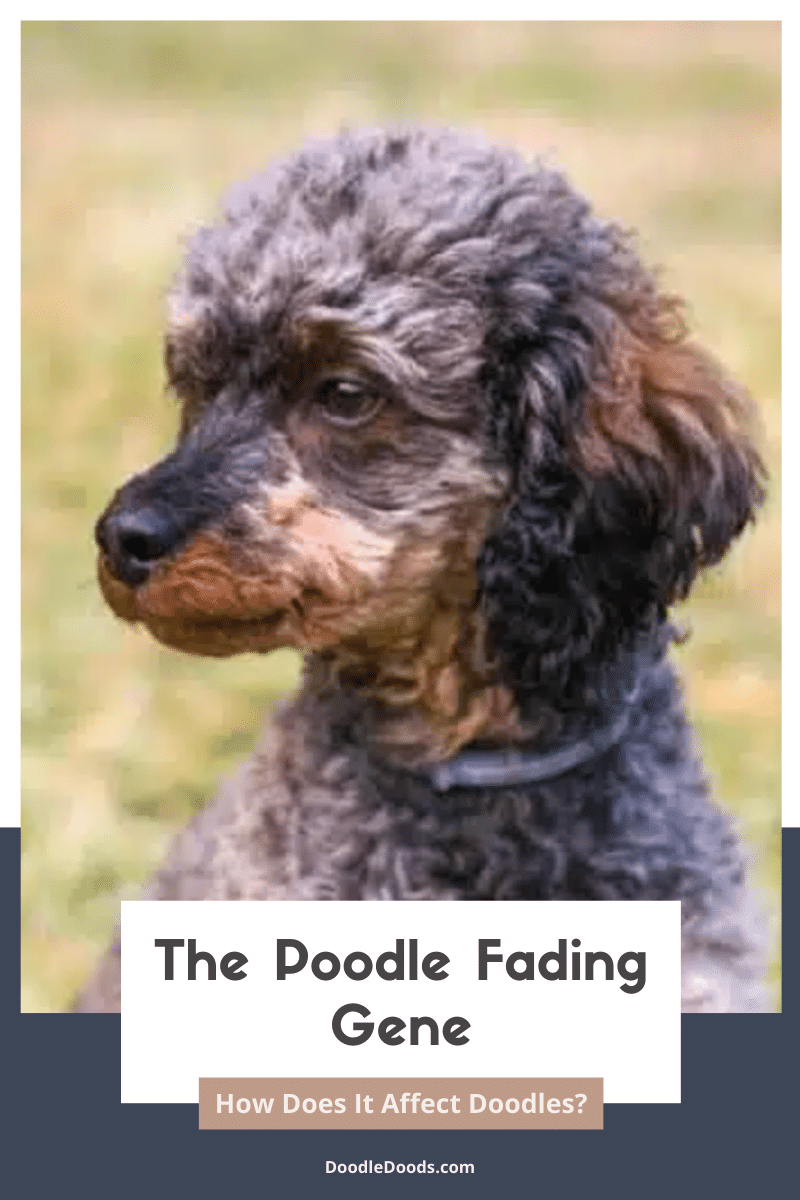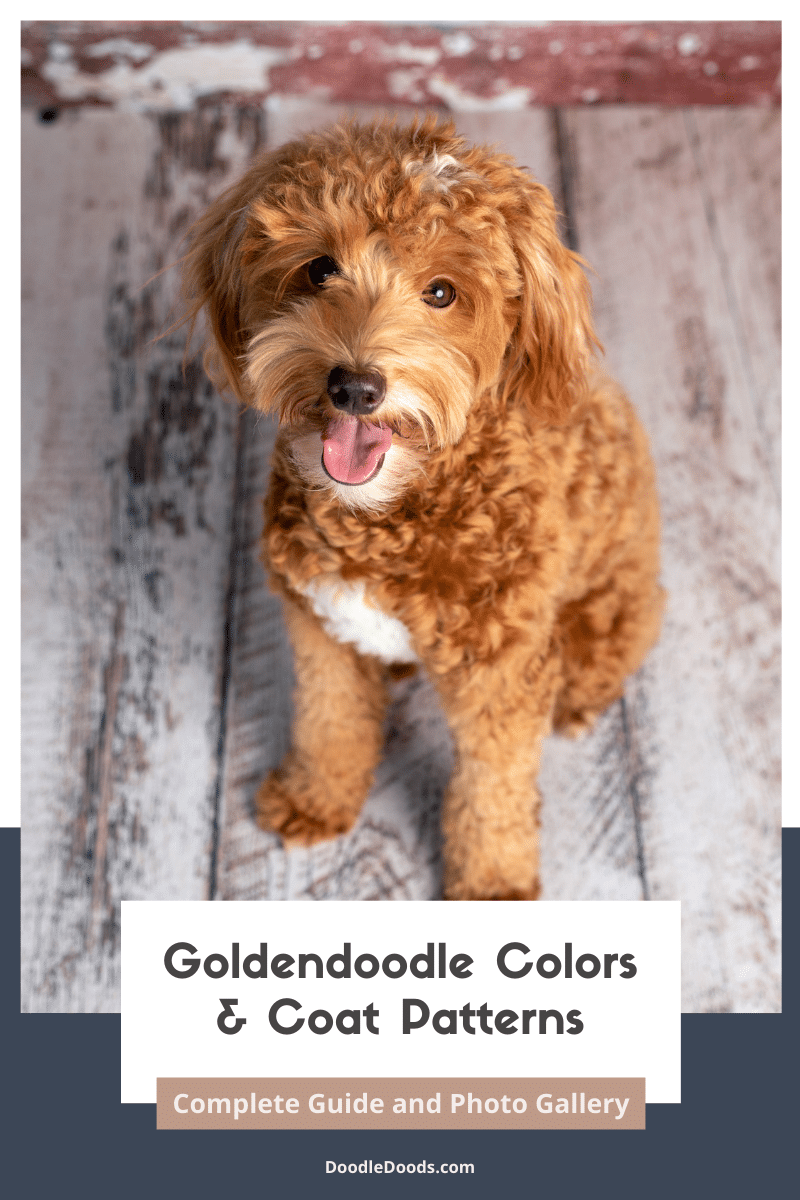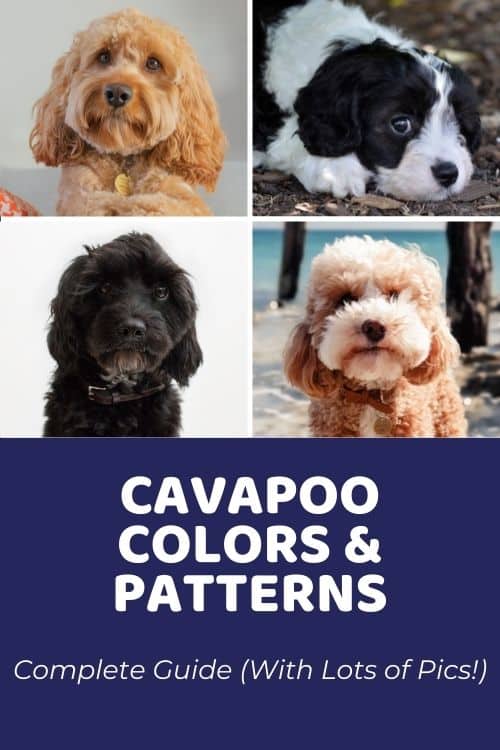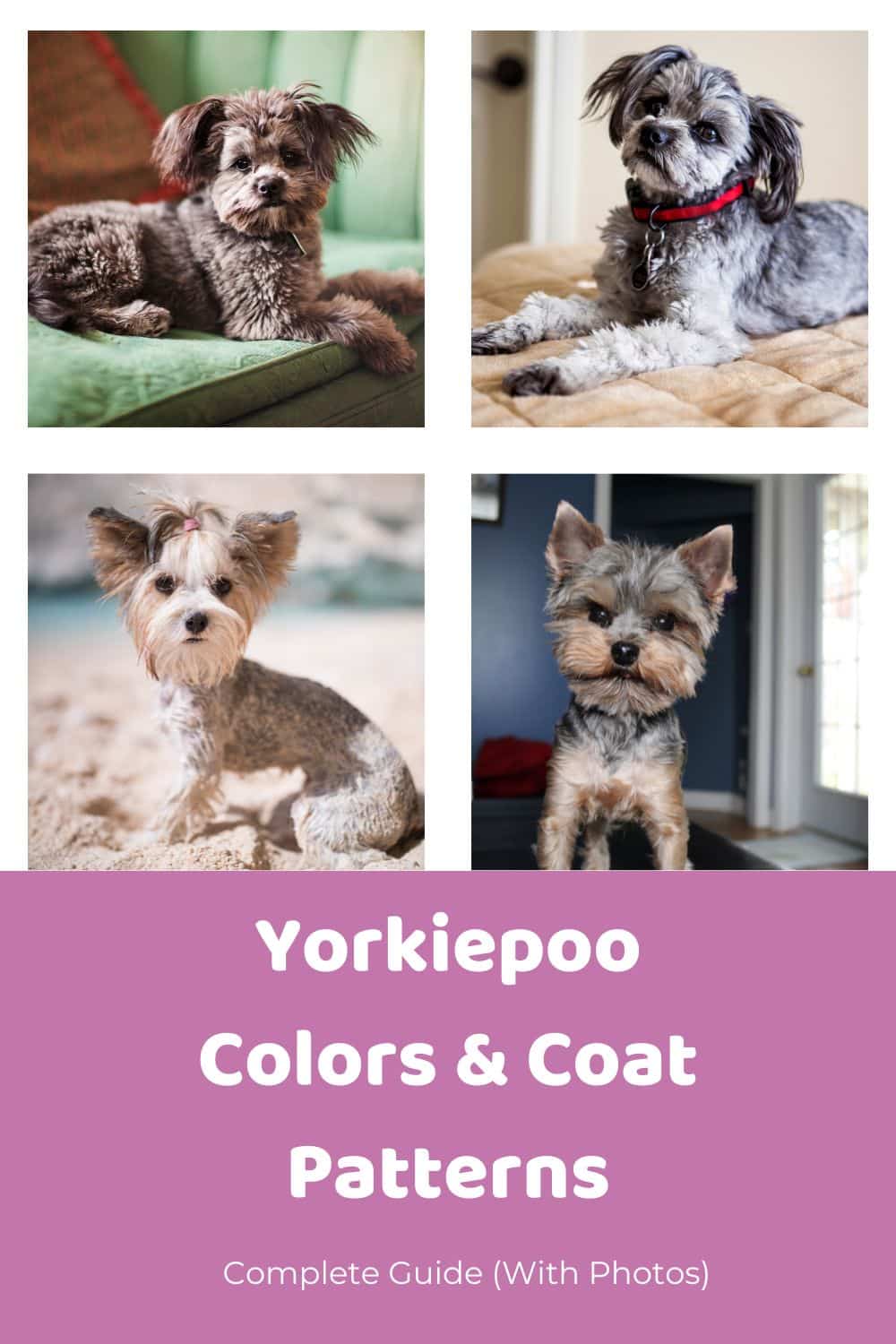If you’re about to adopt a Sheepadoodle puppy, you’ve likely done all of your research. You know what size you’re after, what coat type they should have, and maybe even their generation. So now you’re stuck with the last big question – out of all the Sheepadoodle colors, which one should you choose?
In this guide, we’ll take a look at all the different Sheepadoodle colors and coat patterns (with lots of photos). We’ll also learn if a Sheepadoodle’s color can affect their health, temperament, or behavior. Let’s dive in!
Sheepadoodle Colors: Their Heritage
The amazing and adorable Old English Sheepdog-Poodle mix can flaunt a variety of Sheepadoodle colors and coat patterns. But what determines a Sheepadoodle’s coat color? Their genetics, of course!
As we’re combining two different purebred dogs, we never know what we might get. By combining two different breeds, we’ll also have a wider selection of colors and coat patterns a Sheepadoodle can inherit.
So, before we discover all the beautiful Sheepadoodle colors and coat patterns, let’s discuss a little bit about the colors and patterns of their Poodle and Old English Sheepdog parents.
Old English Sheepdog Colors
Old English Sheepdogs come in a variety of colors, mostly in the blues, grays, and whites. The most common Old English Sheepdog colors and coat patterns are blue and white, blue gray and white, gray and white, grizzle, and grizzle and white.
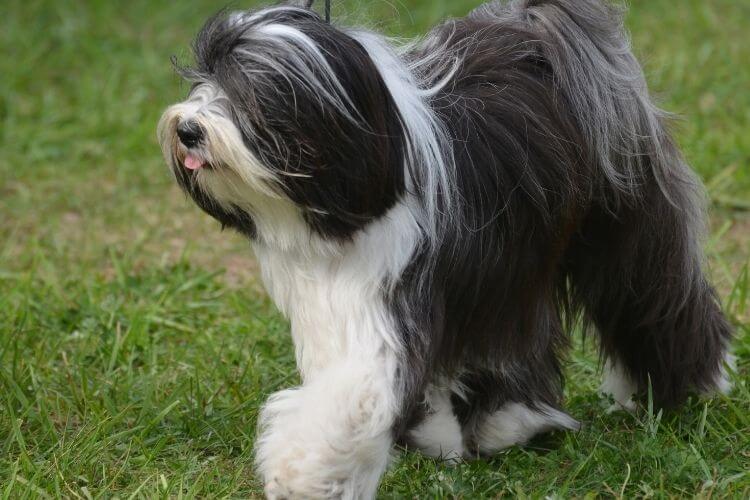
Other possible Old English Sheepdog colors are black and white, blue, blue merle, blue merle and white, brown and white, fawn and white, white, and blue gray.
Poodle Colors
Poodles typically come in solid colors, such as black, silver, gray, blue, brown, cream, apricot, silver beige, cafe au lait, red, and white. However, some Poodles also come with various color combinations like black and brown, black and apricot, black and tan, black and cream, brown and white, brown and apricot, blue and white, and so on.
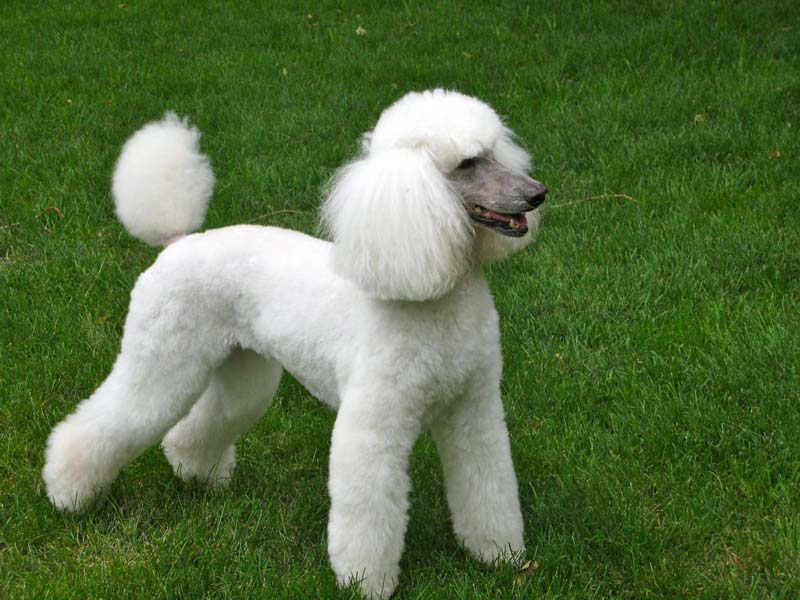
Sheepadoodle Color Chart
Thanks to their diverse genetic pool, Sheepadoodles can come in a variety of colors and coat patterns. Here’s a complete guide of all the possible Sheepadoodle colors, along with links to photos and descriptions of each.
Merle Sheepadoodle
One of the rarest Sheepadoodle colors is the merle pattern. It’s a beautiful, unique pattern that many Doodle owners desire. Merle Sheepadoodles have a combination of similar tones in their coats. They usually have a solid base color with patches of other colors on the body, typically in various shades in the same tonal range.
The merle gene is not common in Poodles, and it’s pretty rare in Old English Sheepdogs as well. However, as the merle gene is dominant, it only takes one pup to carry the merle gene to achieve a merle patterned pup. If you’re after a merle Sheepadoodle, you’ll have to do thorough research to find a good breeder that does thorough genetic testing on their breeding dogs.
In addition to that, the merle gene does possess a greater risk of certain health problems. Most commonly, deafness and blindness. For this reason, ethical breeding practices are crucial and reputable breeders never cross together two merle Sheepadoodles.
Blue Merle Sheepadoodle
Blue merle Sheepadoodles are probably the most common version of the rare merle pattern in Sheepadoodles. These Sheepadoodles usually have a combination of similar tones of blue, gray, and white in their coats. All of them blending into each other and giving the pup the most gorgeous, unique look.
If the goal is to breed a blue merle Sheepadoodle, breeders have to conduct thorough genetic testing on the breeding dogs beforehand. One parent pup should carry the merle gene and the Poodle used in the mix usually comes in solid white.
Black Sheepadoodle
A black Sheepadoodle is another rare Sheepadoodle color. Black Sheepadoodles usually have an all black coat, along with a black nose and eyes. A black Sheepadoodle is relatively rare, because Old English Sheepdogs don’t usually come in an all solid black coat.
To achieve a black Sheepadoodle, the Poodle parent should have an all black coat. It’s also worth mentioning that the solid black coat is more prevalent in backcross generations, where there’s more than 50% of Poodle in a Sheepadoodle’s genetic makeup.
Additionally, darker colored Sheepadoodles, especially black Sheepadoodles, often fade into lighter shades in the same tonal range. Typically into blue, gray, or even silver tones.
Black and White Sheepadoodle
Black and white Sheepadoodle color is one of the most well-known Sheepadoodle colors out there. It’s very much inspired by the Old English Sheepdog parent with its signature black and white pattern all across the body.
The black and white Sheepadoodle color can come in with either solid white color and black patches or solid black color and white patches on the fur. Most commonly, the majority of the body is covered in white, including their chest and paws.
Black and white Sheepadoodles are sometimes also called parti or tuxedo, depending on the pattern that’s on their body. Parti Sheepadoodles have two colors in their coat, where both colors take up about 50% of the body. Tuxedo Sheepadoodles usually come in a black base color with white markings on their face, muzzle, neck, chest, and paws.
What’s more, the black may fade into lighter gray, blue, or silver tones as the pup grows older. This usually happens when a Sheepadoodle has inherited the fading gene.
Gray Sheepadoodle
Gray Sheepadoodles are also quite common, as gray tones can be found in both Old English Sheepdogs and Poodles. Typically, gray Sheepadoodles have patches of white on their body. Most commonly, on the muzzle, neck, chest, and paws. This is also called the tuxedo pattern, which looks like the pup is wearing a tuxedo.
Gray Sheepadoodles can also have other similar colors in their coats. Typically blue tones, silvers, and even a few specks of black.
If you’re after a solid gray Sheepadoodle then unfortunately we have to disappoint you. Solid colors are quite rare, but once in a blue moon you might come across one!
Silver Sheepadoodle
Silver Sheepadoodles are very similar to gray Sheepadoodles, but the silver tones are lighter than gray. Like others, Silver Sheepadoodles tend to come in either bi-color or tuxedo patterns, as they usually have white patches on their body.
Usually, silver Sheepadoodles are born with much darker coats. Thanks to the fading gene, they often start turning lighter already at a few months old.
Blue Sheepadoodle
Blue Sheepadoodles have a similar, grayish tone as silver and gray Sheepadoodles. However, the blue is darker and richer than the typical gray. Similarly, blue Sheepadoodles usually have lighter and darker patches on their body, most commonly, black, gray, silver, or white.
Again, blue Sheepadoodles are often born with much darker coats and they tend to fade into blue tones within their first year from birth. Some pups can also be born with blue coats and fade into the lighter silver color as they reach adulthood.
Brown Sheepadoodle
As brown is prevalent in both Poodles and Old English Sheepdogs, Sheepadoodles can also inherit this beautiful, rich, chocolaty coat color. Most commonly, brown Sheepadoodles have either two or three colors on their coat, others being white and black. Sometimes they can also have patches of lighter tones like cream in their coats.
Some brown Sheepadoodles come in a bi-color pattern, which means that they have two main colors in their coats. Most commonly, brown and white. There’s also the tri-color Sheepadoodle that has black, white, and brown in their coat. Usually, the base color is white and has patches of black fading into brown. However, tri-color Sheepadoodles are definitely more rare than bi-colored pups. The rarest of them all is solid brown, as it’s fairly difficult to breed a solid colored Sheepadoodle.
If the goal is to achieve a brown Sheepadoodle, the Poodle parent used in the mix usually has a red or an apricot coat. Like other darker colored pups, brown Sheepadoodles may fade lighter as they start reaching adulthood. Typically in red, fawn, cream, or even silver beige tones.
Red Sheepadoodle
Now we’re entering the territory of rare Sheepadoodle colors. Red Sheepadoodles are relatively difficult to find, but there are some pups who flaunt this beautiful coat. Similarly to other Sheepadoodle colors, those very rare red Doods usually come with white or cream patches on their face, neck, chest, or paws.
As red isn’t common in Old English Sheepdogs, the Poodle used in the mix should have a red coat. In addition to that, red Sheepadoodles often fade into lighter fawn or cream tones as they grow up.
Fawn Sheepadoodle
Fawn Sheepadoodles have a similar toned coat as brown or red Sheepadoodles, but the fawn is lighter and more diluted compared to the other two. These pups also tend to come in a fawn base color with white markings on their body and face.
Cream Sheepadoodle
Cream Sheepadoodles sport a diluted brown coat color, which is lighter compared to fawn Sheepadoodles. Again, they tend to have white markings on their face, muzzle, chest, and paws.
Oftentimes, cream Sheepadoodles are born with a richer colored coat, such as brown, red, or fawn. On the other hand, some Sheepadoodles are born with a cream coat and they might not change color as they age. This is why it’s especially tricky to predict how a puppy might look once they’re fully-grown.
Sable Sheepadoodle
Sable Sheepadoodles are very rare and difficult to find. They have a solid base color, but the hairs have black tips. There are different degrees of the sable pattern – some pups might look all black at first while others have only a tiny amount of black in the hair tips.
As the sable pattern tends to go hand-in-hand with the fading gene, these Doods usually grow out of their black-tipped hairs. However, sable Sheepadoodles may still have darker ears as they become adults.
Grizzle Sheepadoodle
A nod to the Old English Sheepdog lineage is the grizzle Sheepadoodle color. Grizzle color is a mix of different colors with no particular pattern. The colors appear blended together and are only more visible when you look at them closely. Some grizzle Sheepadoodles have black, brown, and tan colors mixed together, while others have a mix of black and white that appears as gray.
Does A Sheepadoodle’s Color Change?
Like with many other Doodles, it’s not uncommon for a Sheepadoodle to change color. Sheepadoodles often fade in color as they grow up. The fading usually happens around 6 to 12 months old, as they start nearing adulthood. It’s caused by a progressive graying gene called G locus that’s common in both Poodles and Old English Sheepdogs.
The Sheepadoodle color change is most noticeable in dark haired Sheepadoodles who have blacks and dark browns in their coats. Black Sheepadoodles who have inherited the graying gene often fade into various shades of gray, silver, or blue. Similarly, brown Sheepadoodles may fade into lighter colors in the same tonal range, such as cafe au lait, cream, silver beige, or silver.
In addition to that, sable Sheepadoodles almost always inherit the fading gene. Therefore, if you’ve got a sable colored puppy, be prepared to discover their new coat color as they become older.
Does Coat Color Affect Sheepadoodle’s Health And Behavior?
Whether you prefer a black and white Sheepadoodle or you’re after something a bit more rare, a Sheepadoodle’s color does not affect their health, temperament, or behavior. All pups are unique and have their own personalities. Some puppies are more extraverted, some are more independent by nature.
However, if you do notice some unwanted behaviors, it’s best if you reach out to a professional dog trainer or try an online puppy school. As long as you stay consistent, you’ll notice your pup quickly picking up new behaviors and manners.
That being said, the merle gene has been linked with certain health issues, such as blindness and deafness. Therefore, ethical breeders never breed together two merle dogs and always conduct thorough genetic testing beforehand.
Sheepadoodle Colors: Which One Should You Get?
When trying to decide between all the possible Sheepadoodle colors and coat patterns, it all comes down to your own personal preferences. You should also keep in mind that Sheepadoodles can change color and fade as they reach adulthood.
That being said, we hope that your future companion’s looks aren’t the only thing you’re basing your decision on. Above all, you should adopt a puppy whose temperament fits yours, your household dynamics, and your lifestyle.
Sheepadoodle Colors: Frequently Asked Questions
What Is The Rarest Sheepadoodle Color?
The rarest Sheepadoodle colors are solid black, solid brown, solid gray, and solid white. These are typically the hardest to come across, as even mostly black Sheepadoodles tend to have white markings on their chest and neck.
Other rare Sheepadoodle colors are merle and sable. For example, the merle gene is very rare in Poodles and Old English Sheepdogs, but again, not impossible to come across. If you’re after very rare Sheepadoodle colors, be prepared to pay a little bit extra.
Do All Sheepadoodles Turn Gray?
Many, but not all Sheepadoodles turn gray as they age. Like many other Doodles, Sheepadoodles often inherit the fading gene. Most commonly, darker Sheepadoodles fade as they grow up and reach adulthood.
For instance, Sheepadoodles who have black in their coat often fade into various tones of gray, silver, or blue. Similarly, Sheepadoodles with brown tones in their coat might fade into lighter, creamier shades.
Are All Sheepadoodles Black And White?
Although the black and white Sheepadoodle color is very common, not all Sheepadoodles come in this color combination. As the Sheepadoodle’s genetic pool is so diversified, there are various color combinations that these pups may inherit. In addition to that, many black and white Sheepadoodles can fade into lighter tones like gray, blue, and silver.
Can A Sheepadoodle Be Brown?
Yes! A Sheepadoodle can absolutely be brown, but solid brown Sheepadoodles are relatively rare. Typically brown Sheepadoodles also have other colors in their coat, such as white markings or some black patches. To achieve a brown Sheepadoodle, the Poodle parent used in the mix should have either a red or apricot colored coat.
On the other hand, it’s not uncommon for brown Sheepadoodles to fade into lighter tones as they reach adulthood. Brown Sheepadoodles may fade into cream, cafe au lait, silver beige, or even silver.
What Is A Blue Merle Sheepadoodle?
A blue merle Sheepadoodle has a mix of different shades of blue, gray, and white all over the body. A blue merle Sheepadoodle is fairly difficult to find, but not impossible. Typically, you’ll have to pay extra for rare Sheepadoodle colors like blue merle, as they’re extremely sought after.
Sheepadoodle Colors: Final Thoughts
Like their Poodle and Old English Sheepdog parents, Sheepadoodles can come in an array of colors and coat patterns, some of them more common and others more rare. As there are so many Sheepadoodle colors to choose from, deciding on one can prove to be quite a pickle. They all look so cute, regardless of their coat color!
Now that you’ve learned about all the different Sheepadoodle colors and coat patterns, we hope that you’re one step closer to making the decision before adopting your new furry family member.


